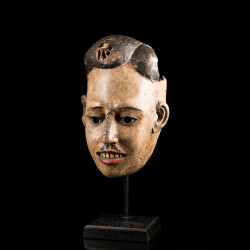













The face of the mask is very naturalistic and human, with accentuated dark eyebrows, eyes, a thin nose and a toothy mouth with red lips. The mask's hairstyle is elaborate, with black lobes.
The general condition of this mask is for any collector the best, the pigmentation is original but especially the condition of this mask is simply incredible, the pictures speak for themselves. Signs of very marked wear are visible, they follow a ritual use during ceremonial dances, the inside of the mask is very explicit and summarizes perfectly our expertise.
You are looking at a rare, high quality, uncommon work. Indeed, this type of mask with its specific iconography and typology is not common, and collectors specialising in Nigerian artworks will be able to attest to this. This work is quite simply quite special, the type of object that will certainly add major value to the foundation of a private collection.
The contextual photograph we are pleased to enclose is from the archives of the Museum of Archaeology and Anthropology, dated 1932 and with inventory number N.13198.GIJ.
This negative was kept in a film storage album labelled "IBIBIO & OKWU WALL" by G. I. Jones, and numbered "C12/".
Background: "The Cross River masquerade called Ikem spread from Old Calabar to Ibibio country in the early decades of the twentieth century and Anang carvers were producing skin-covered heads in this style by the early 1930s, if not much earlier, equal to the best that had been made in Ejagham country and in Old Calabar. Some minor differences distinguished these Anang heads, the most obvious being their drooping upper eyelids. The Ikem masquerade and heads in this modified Cross River style spread to the Umuahia region and as far north as Ozu Item. But the Ikem masquerade seems to have inspired the Akang to produce similar masquerades and their own variation of these heads in what was considered locally to be a completely naturalistic style. The hair, eyes and lips were painted with a transparent varnish. The associated masquerade, which was given different names in different regions, was widespread among their Ibibio and Ibo neighbours. During the colonial period, the demand for Anang sculptures increased, but especially for masks, heads and figures in this modern naturalistic style. It was indeed a very successful compromise between the traditional Anang (Ibibio) style and the 'traditional European' style, i.e. Victorian naturalism and the classical Greek sculpture that inspired it." (Jones 1984, pp.184-185)
Data sheet
You might also like